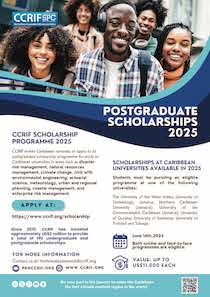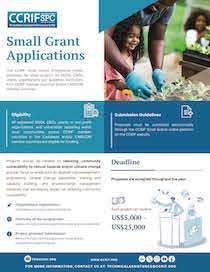A tropical wave produced periods of rain/showers and thunderstorm activity over north-eastern Jamaica on 16 August 2019.
This event briefing describes the impact of the precipitation on the island of Jamaica over the period 16-18 August 2019. The Rainfall Index Loss (RIL) calculated for this Covered Area Rainfall Event (CARE), which occurred in Jamaica, starting on 16 August and ending on 18 August 2019 was below the attachment point of Jamaica’s Excess Rainfall policy and therefore no payout is due.
A magnitude 5.9 earthquake occurred at 05:54:55 UTC on 31 July 2019 (30 July 2019 at 23:54:55 local time), 24.6 km (15.3 mi) N of La Libertad, El Salvador; 45.9 km (28.5 mi) N of Santa Tecla, El Salvador and 46.6 km (28.9 mi) NNE of San Marcos, El Salvador. Initial estimates from the United States Geological Survey (USGS) located the epicentre of the event (Figure 1) at 13.266°N, 89.338°W, and at a depth of 72.5 km (45 mi). Nicaragua was the only CCRIF member country where peak ground acceleration, computed with the SPHERA model, was greater than 0.01g for this earthquake.
A magnitude 5.2 earthquake occurred at 00:09:02 UTC on 8 July 2019 (7 July 2019 18:09:02 local time), 25.4 km (15.8 mi) N of La Cruz, Costa Rica; 31.4 km (19.5 mi) SE of Liberia, Costa Rica and 69 km (42.9 mi) NNW of Rivas, Nicaragua. Final estimates from the United States Geological Survey (USGS) located the epicentre of the event (Figure 1) at 10.844°N, 85.632°W, and at a depth of 60.7 km (37.7 mi). Nicaragua was the only CCRIF member country where peak ground acceleration, computed with the SPHERA model, was greater than 0.01g for this earthquake.
A tropical wave and an active Inter-Tropical Convergence Zone (ITCZ) produced prolonged periods of rain/showers and thunderstorm activity over Trinidad and Tobago between 17 and 19 June 2019, generating adverse weather in Trinidad.
This event briefing describes the impact on the island of Trinidad of the heavy precipitation received during this period. The Rainfall Index Loss (RIL) calculated for this Covered Area Rainfall Event (CARE), which occurred in Trinidad, starting on 17 June and ending on 19 June 2019.
During the second half of May, a persistent area of low pressure located over the eastern Pacific Ocean created conditions favourable for the development of thunderstorms and showers over Central America and the surrounding waters1 2. In particular, the Nicaraguan territory was affected by high thunderstorm activity and associated heavy precipitation.
A magnitude 5.9 earthquake occurred at 16:22:16 UTC on 16 May 2019 (10:22:16 local time), 45.9 km (28.5 mi) ENE of Jiquilillo, Nicaragua; 78.7 km (48.9 mi) E of Chinandega, Nicaragua and 75 km (46.6 mi) E of El Viejo, Nicaragua. Estimates from the United States Geological Survey (USGS) located the epicentre of the event (Figure 1) at 12.624°N, 87.856°W, and at a depth of 62.0 km (38.5 mi). Nicaragua was the only CCRIF member country where peak ground acceleration, computed with the MPRES model, was greater than 0.01g for this earthquake.
A magnitude 5.6 earthquake occurred at 12:01:48 UTC on 26 March 2019 (06:01:48 local time), 110.2 km (68.5 mi) N of La Libertad, El Salvador; 114.4 km (71.1 mi) NE of Puerto El Triunfo, El Salvador and 118 km (73.3 mi) NNE of Zacatecoluca, El Salvador. Initial estimates from the United States Geological Survey (USGS) located the epicentre of the event (Figure 1) at 12.496°N, 89.233°W, and at a depth of 10.0 km (6.2 mi).
A magnitude 5.3 earthquake occurred at 09:30:02 UTC on 24 March 2019 (03:30:02 local time), 26.9 km (16.7 mi) NE of Nagarote, Nicaragua; 39.1 km (24.3 mi) NNW León, Nicaragua and 44.7 km (27.8 mi) E Ciudad Sandino, Nicaragua. Initial estimates from the United States Geological Survey (USGS) located the epicentre of the event (Figure 1) at 12.107°N, 86.752°W, and at a depth of 95.7 km (59.5 mi).
A magnitude 5.3 earthquake occurred at 03:41:04 UTC on 15 January 2019 (14 January 2019 21:41:04 local time), 56.7 km (35.2 mi) NNE of Masachapa, Nicaragua; 65.4 km (40.6 mi) NNE of San Rafael del Sur, Nicaragua and 75.9 km (47.1 mi) NNE of Diriamba, Nicaragua.
An active Inter-Tropical Convergence Zone (ITCZ) produced prolonged periods of rain/showers and thunderstorm activity over Trinidad and Tobago between 14 and 16 November 2018, generating adverse weather mainly over the East and South of Trinidad. This event briefing describes the impact on the island of Trinidad which was affected by heavy precipitation during this period.





